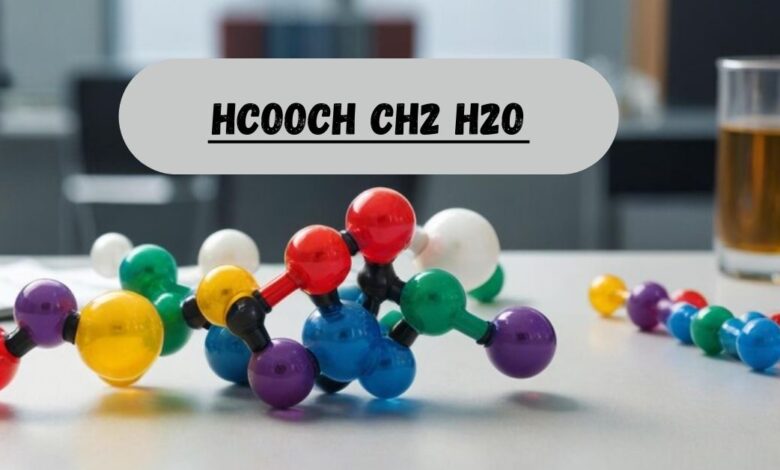Understanding the Hcooch Ch2 H2o of Methyl Formate: A Comprehensive Guide
The world of chemical reactions is vast, with each process offering a unique insight into how substances transform and interact. One such reaction that plays a crucial role in both laboratory and industrial applications is the Hcooch Ch2 H2o of methyl formate (HCOOCHCH2). In this article, we will delve into the Hcooch Ch2 H2o of methyl formate, focusing on its reaction mechanism, industrial uses, influencing factors, and safety considerations. Whether you’re in the lab or dealing with large-scale processes, understanding this reaction can enhance your approach to chemical synthesis.
What is Methyl Formate?
Methyl formate, also known as formic acid methyl ester, is a simple ester compound with the molecular formula HCOOCHCH2. It is an important chemical intermediate used in various industrial applications, including the production of flavorings, fragrances, and as a solvent. However, methyl formate’s significance extends beyond its industrial applications, as it can undergo Hcooch Ch2 H2o, a reaction that is fundamental to many chemical processes.
The Hcooch Ch2 H2o Process
Hcooch Ch2 H2o is the process in which water breaks down a compound. In the case of methyl formate, Hcooch Ch2 H2o involves the addition of water (H2O) to methyl formate, resulting in the formation of methanol (CH3OH) and formic acid (HCOOH). The reaction can be represented as follows:
HCOOCH2 + H2O → CH3OH + HCOOH
This reaction is essential for various industrial and laboratory applications, as it allows for the controlled production of methanol and formic acid, both of which are important chemicals in their own right.
Reaction Mechanism
The Hcooch Ch2 H2o of methyl formate occurs through a nucleophilic attack mechanism, which involves the interaction between the water molecule and the ester group. Here’s a simplified explanation of the steps involved:
- Nucleophilic Attack: The lone pair of electrons on the oxygen atom in the water molecule attacks the carbonyl carbon of the ester group. This forms a tetrahedral intermediate.
- Formation of Products: The tetrahedral intermediate breaks down, releasing methanol and leaving behind a formate ion.
- Protonation: The formate ion (HCOO-) is protonated to form formic acid (HCOOH).
This reaction can be catalyzed by either an acid or a base, with acidic conditions being more common for this process in industrial applications.
Industrial Uses of Hcooch Ch2 H2o of Methyl Formate
The Hcooch Ch2 H2o of methyl formate is widely used in the chemical industry, particularly for the production of methanol and formic acid. These two chemicals are essential in many processes:
- Methanol Production: Methanol, a key building block in the chemical industry, is produced from the Hcooch Ch2 H2o of methyl formate. It is used as a solvent, fuel, and in the synthesis of various chemicals, such as formaldehyde, acetic acid, and plastics.
- Formic Acid Production: Formic acid, produced in the Hcooch Ch2 H2o process, is widely used as a preservative in animal feed, as a coagulant in rubber production, and in leather tanning. It also serves as a reducing agent in various chemical reactions.
- Flavorings and Fragrances: Both methanol and formic acid are used in the food and fragrance industries. Methyl formate itself is sometimes used as a flavoring agent, contributing to the characteristic taste of fruits like apples and pineapples.
The ability to hydrolyze methyl formate efficiently ensures a steady supply of these valuable chemicals, making the process vital to large-scale manufacturing.
Influencing Factors in the Hcooch Ch2 H2o of Methyl Formate
The rate of Hcooch Ch2 H2o of methyl formate can be influenced by several factors, including temperature, pH, and the presence of catalysts. Let’s take a closer look at how each factor plays a role:
- Temperature: Temperature plays a significant role in the Hcooch Ch2 H2o reaction. As temperature increases, the rate of reaction typically increases, as higher temperatures provide more energy for the molecules involved in the reaction. However, extremely high temperatures can lead to the degradation of the products or the formation of unwanted side products.
- pH: The pH of the reaction medium can also influence the reaction. Acidic conditions generally promote the Hcooch Ch2 H2o of methyl formate, as the protonation of the ester bond helps facilitate the nucleophilic attack by water molecules. In contrast, basic conditions may lead to the formation of methanol and formate ion but at a slower rate.
- Catalysts: The presence of an acid or base catalyst can speed up the Hcooch Ch2 H2o process. Acidic catalysts, such as sulfuric acid, are commonly used in industrial applications because they help break the ester bond more efficiently. Basic catalysts, on the other hand, are less frequently used but can still be effective in promoting Hcooch Ch2 H2o.
Safety Considerations
While the Hcooch Ch2 H2o of methyl formate is a useful and widely applied reaction, it’s crucial to consider safety precautions, especially in industrial settings where large quantities of chemicals are handled.
- Handling Methyl Formate: Methyl formate itself is flammable and toxic. Care should be taken when storing and handling the substance to avoid exposure to open flames and sparks. Proper ventilation is essential to prevent the buildup of flammable vapors.
- Byproducts: The Hcooch Ch2 H2o of methyl formate produces methanol and formic acid, both of which have safety implications. Methanol is toxic if ingested or inhaled, while formic acid is corrosive and can cause severe skin and eye irritation. Protective gear, including gloves, goggles, and face shields, should be worn to minimize exposure.
- Reaction Conditions: Since the Hcooch Ch2 H2o reaction often occurs under acidic conditions, safety measures should be in place to handle any acid spills. Neutralizing agents, such as sodium bicarbonate, should be readily available in case of an accidental release.
- Environmental Impact: The production of methanol and formic acid should be done with careful attention to waste management. Proper disposal methods for chemicals and their byproducts must be followed to avoid environmental contamination.
Laboratory Applications
In laboratory settings, the Hcooch Ch2 H2o of methyl formate is often used to synthesize formic acid and methanol. It is also a valuable reaction for teaching students about ester chemistry and nucleophilic substitution reactions. The reaction can be easily carried out in a controlled environment using a simple water bath or reflux system.
Researchers also use the Hcooch Ch2 H2o of methyl formate in the development of new catalysts or in studies aimed at improving the efficiency of Hcooch Ch2 H2o reactions. Understanding the mechanism and influencing factors can provide insights into designing more efficient industrial processes.
Conclusion
The Hcooch Ch2 H2o of methyl formate (HCOOCHCH2) is an essential reaction in both industrial and laboratory settings. Its ability to produce methanol and formic acid makes it valuable for a wide range of applications, from chemical production to flavoring agents. By understanding the reaction mechanism, influencing factors, and safety considerations, we can harness the full potential of this reaction while minimizing risks. Whether you’re a chemist in a lab or an engineer in an industrial plant, the Hcooch Ch2 H2o of methyl formate is a reaction worth mastering.






